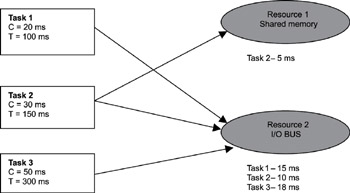Книга: Real-Time Concepts for Embedded Systems
14.4.2 Extended RAM Schedulability Test
14.4.2 Extended RAM Schedulability Test
The basic RMA is limiting. The second assumption associated with basic RMA is impractical because tasks in real-time systems have inter-dependencies, and task synchronization methods are part of many real-time designs. Task synchronization, however, lies outside the scope of basic RMA.
Deploying inter-task synchronization methods implies some tasks in the system will experience blocking, which is the suspension of task execution because of resource contention. Therefore, the basic RMA is extended to account for task synchronization. Equation 14.2 provides the equation for the extended RMA schedulability test.

where:
Ci = worst case execution time associated with periodic task I
Ti= period associated with task i
Bi= the longest duration of blocking that can be experienced by I
n = number of tasks
This equation is best demonstrated with an example. This example uses the same three tasks provided in Table 14.3 and inserts two shared resources, as shown in Figure 14.7. In this case, the two resources represent a shared memory (resource #1) and an I/O bus (resource #2).

Figure 14.7: Example setup for extended RMA.
Task #1 makes use of resource #2 for 15ms at a rate of once every 100ms. Task #2 is a little more complex. It is the only task that uses both resources. Resource #1 is used for 5ms, and resource #2 is used for 10ms. Task #2 must run at a rate of once every 150ms.
Task #3 has the lowest frequency of the tasks and runs once every 300ms. Task #3 also uses resource #2 for 18ms.
Now looking at schedulability, Equation 14.2 yields three separate equations that must be verified against a utility bound. Let's take a closer look at the first equation

Either task #2 or task #3 can block task #1 by using resource #2. The blocking factor B1 is the greater of the times task #2 or task #3 holds the resource, which is 18ms, from task #3. Applying the numbers to Equation 14.2, the result is below the utility bound of 100% for task #1. Hence, task #1 is schedulable.
Looking at the second equation, task #2 can be blocked by task #3. The blocking factor B2is 18ms, which is the time task #3 has control of resource #2, as shown

Task #2 is also schedulable as the result is below the utility bound for two tasks. Now looking at the last equation, note that Bnis always equal to 0. The blocking factor for the lowest level task is always 0, as no other tasks can block it (they all preempt it if they need to), as shown

Again, the result is below the utility bound for the three tasks, and, therefore, all tasks are schedulable.
Other extensions are made to basic RMA for dealing with the rest of the assumptions associated with basic RMA, such as accounting for aperiodic tasks in real-time systems. Consult the listed references for additional readings on RMA and related materials.
- Parameter problem
- rc.test-iptables.txt
- 2. How to Apply These Terms to Your New Programs
- Example rc.test-iptables script
- The Programmers
- Testing the Project
- Instagram как платформа для реализации.
- Специфика .NET Compact Framework: ADO.NET
- Testing Wdm2 Power Capabilities
- Для чего нужны папки Windows, Documents and Settings, Program Files и Temp?
- Test Driver Code
- Можно ли указать использование по умолчанию вместо C:Program Files другого каталога для установки программ?




